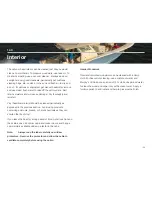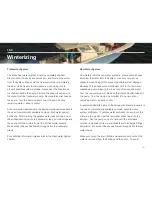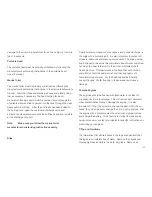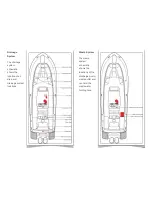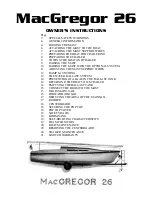
aft slings should be tied together to prevent the slings from
sliding on the hull.
BOATS CAN BE DAMAGED FROM IMPROPER LIFTING AND TRANSPORTING
WITH FORK LIFTS. CARE AND CAUTION MUST BE EXERCISED WHEN
TRANSPORTING A BOAT WITH A FORK LIFT. NEVER HOIST THE BOAT
WITH A SUBSTANTIAL AMOUNT OF WATER IN THE BILGE.
SEVERE GEL COAT CRACKING OR MORE SERIOUS HULL DAMAGE CAN
OCCUR DURING HAULING AND LAUNCHING IF PRESSURE IS CREATED
ON THE GUNWALES (SHEER) BY THE SLINGS. FLAT, WIDE BELTING
SLINGS AND SPREADERS LONG ENOUGH TO KEEP PRESSURE
FROM THE GUNWALES ARE ESSENTIAL. DO NOT ALLOW ANYONE
TO HAUL YOUR BOAT WHEN THE SPREADERS ON THE LIFT ARE NOT WIDE ENOUGH TO
TAKE THE PRESSURE OFF THE GUNWALES.
Supporting The Boat For Storage
A trailer, elevating lift, or a well-made cradle is the best support
for your boat during storage.
When storing the boat on a trailer for a long period:
•
Make sure the trailer is on a level surface and the bow is
high enough so that water will drain from the bilge and cockpit.
•
Make sure the engines are in the down position.
•
The trailer must properly support the hull. The bunks and
rollers should match the bottom of the hull and should not be
putting pressure on the lifting strakes.
•
Make sure the hitch is properly supported.
•
Check the tires once each season. Add enough air for the
correct amount of inflation for the tires as necessary.
Note:
Read the owner’s manual for the trailer for the
correct amount of inflation for the tires.
When storing the boat on a lift or cradle:
•
The cradle must be specifically for boat storage.
•
Make sure the cradle or lift is well supported with the bow
high enough to provide proper drainage of the bilge.
•
Make sure the engines are in the down position.
•
The cradle or lift must be in the proper fore and aft position
to properly support the hull. When the cradle or lift is in the
139
Sling Locations Marked on Boat
Summary of Contents for 320 LXF
Page 1: ...320 LXF Scout Boats OWNER MANUAL ...
Page 2: ...Chapter 1 Owner s Information Warranty Certification and Boat Information ...
Page 11: ...Chapter 2 Propulsion A guide to your boat s propulsion system ...
Page 32: ...Chapter 4 Fuel System An overview of the fuel system of your boat ...
Page 40: ...Chapter 5 Electrical System An overview of the electrical system of your boat ...
Page 54: ...Chapter 6 Fresh Water System An overview of the fresh water system of your boat ...
Page 59: ...Chapter 7 Raw Water System An overview of the raw water system of your boat ...
Page 65: ...Chapter 8 Drainage System An overview of the drainage system of your boat ...
Page 70: ...Chapter 9 Ventilation System An overview of the ventilation system of your boat ...
Page 73: ...Chapter 10 Exterior Equipment An overview of the exterior equipment on your boat ...
Page 83: ...Chapter 11 Interior Equipment An overview of the interior equipment on your boat ...
Page 88: ...Chapter 12 Safety Equipment An overview of the safety equipment on your boat ...
Page 99: ...Chapter 13 Operation A general guide to operating your boat ...
Page 124: ...Chapter 14 Routine Maintenance A guide to keeping your boat running in good condition ...
Page 147: ...Chapter 16 Appendix Reference documents logs and schematics for your boat ...
Page 154: ...153 ...
Page 155: ...154 ...
Page 156: ...155 ...
Page 157: ...156 ...
Page 159: ...158 ...
Page 160: ...159 ...
Page 162: ...161 ...










